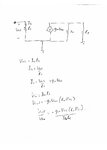Follow along with the video below to see how to install our site as a web app on your home screen.
Note: This feature may not be available in some browsers.
How do I calculate Vout/Vin of this arrangement:
View attachment 121875
I have to do this using the small signal model, I am a beginner level electronics student so a complete explanation would be nice.
Replace the MOSFET with its small signal model. So you have a current source from drain to source, whose value depends on the transconductance as well as the gate-to-source voltage. You don't have body effect in this case, right? Then, consider the output resistance due to channel length modulation. Once you put these together, you basically have one node where you can use KCL - you've reduced the circuit to a very simple linear circuit.
Also consider what happens to VDD in the SSM - AC ground.
Show us what you have and where you're stuck.

1) What is the Rs and why do you have it there?
2) What do we know about Ig of MOSFETs at DC? (Zero)